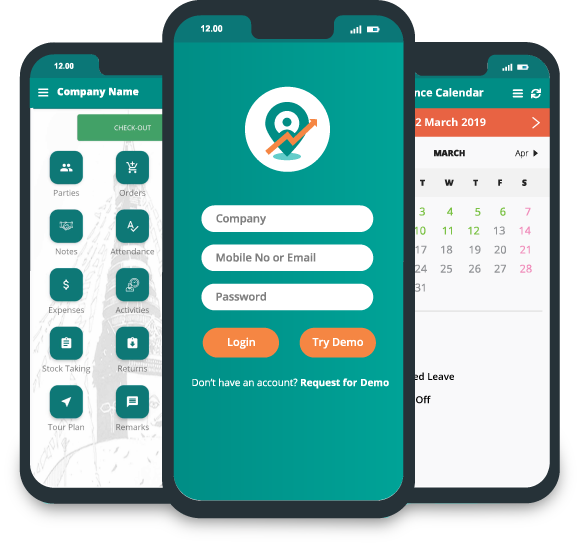Optimizing Field Sales Team Territories: A Comprehensive Guide

Are you looking to boost your field sales team's performance and maximize revenue? If so, then you've come to the right place! In this comprehensive guide, we will take you through the ins and outs of optimizing field sales team territories. From identifying key markets to creating balanced territories that drive productivity, we'll equip you with all the strategies and tools you need for success. So get ready to revolutionize your field sales approach and unlock untapped potential in your business!
Introduction: The Importance of Field Sales Team Territories
Field sales teams play a crucial role in driving revenue for businesses. They are responsible for building relationships with clients, promoting products and services, and closing deals. However, the success of a field sales team is highly dependent on how territories are assigned to them.
Territory management refers to the process of dividing a geographical region into smaller areas that are assigned to individual sales representatives or teams. These territories act as their mini-market, with defined boundaries and specific target customers. Effective territory management ensures that resources are allocated efficiently and allows the field sales team to focus on their designated area, resulting in higher productivity and increased revenue.
In this comprehensive guide, we will discuss the importance of field sales team territories and provide valuable insights on how to optimize them for maximum effectiveness.
1. Better Resource Allocation:
Field sales teams often have limited time and resources at their disposal. By assigning territories to different reps or teams, companies can ensure that they make the most out of their available resources. Each territory can have its own set of goals, strategies, and marketing plans tailored according to the needs of its specific customer base.
For instance, an urban area may require more aggressive marketing tactics compared to a rural one where building personal relationships with customers might be more effective. By allocating resources based on these factors, companies can improve the efficiency and productivity of their field sales team.
2. Increased Focus:
Assigning territories also helps streamline the efforts of a field sales team by providing them with clear objectives within defined boundaries
Understanding Territory Management: Definition and Benefits
Territory management is a crucial aspect of field sales team optimization. It involves dividing the geographic area that a sales team covers into smaller, manageable territories. This allows for better organization, efficiency, and ultimately, improved sales performance.
To put it simply, territory management is the process of assigning specific areas to individual members or teams within a sales force. These territories can be based on various factors such as geography, customer demographics, product categories, or market segments.
Benefits of Territory Management:
1. Enhanced Efficiency:
By dividing an entire region into smaller territories, each member of the sales team can focus on their assigned area more effectively. This ensures that they have a better understanding of their customer's needs and are able to provide them with personalized attention and service. With clearly defined boundaries, there is less overlap in responsibilities between team members which leads to increased productivity and efficiency.
2. Improved Customer Relationships:
With territory management, sales reps can develop stronger relationships with their customers since they are responsible for serving a specific area consistently. They become familiar with the local market dynamics and understand their customers' unique needs better. As a result, they are able to tailor their approach accordingly and build trust with their customers.
3. Better Time Management:
Territory management also helps in optimizing time management for field sales teams. By designating specific areas for each rep to cover, there is less travel time between meetings and appointments within their territory. This reduces time wastage in commuting between different
Factors to Consider when Optimizing Territories
When it comes to optimizing territories for your field sales team, there are several key factors that need to be taken into consideration. These factors can greatly impact the effectiveness and efficiency of your team, as well as their overall success in meeting sales targets. In this section, we will delve into the various elements that should be considered when optimizing territories for your field sales team.
1. Geographic location: The first factor to consider when optimizing territories is the geographic location of each territory. This includes both physical distance and accessibility to customers. It is important to divide territories in a way that minimizes travel time and maximizes coverage of potential clients within each territory.
2. Target market: Another crucial factor is understanding your target market for each territory. This includes demographic information such as age, income level, interests, and buying behavior. By analyzing this data, you can determine which products or services are most likely to be successful in each territory and assign appropriate resources accordingly.
3. Sales history: Analyzing past sales performance in different territories can provide valuable insights on how to optimize them moving forward. Look at trends in sales volume, customer demographics, and product preferences to identify patterns and make informed decisions about resource allocation.
4. Customer density: The number of potential customers within a given area can greatly influence the effectiveness of a territory. A higher concentration of potential buyers means more opportunities for sales within a smaller area, while lower-density areas may require more effort from your team to reach their targets.
5. Competitor presence
- Geographical factors
Geographical factors play a crucial role in the optimization of field sales team territories. These factors not only impact the efficiency and productivity of the sales team but also have a significant influence on customer satisfaction and revenue generation.
Here are some key geographical factors that should be considered when optimizing field sales team territories:
1. Location of Target Market: The first step in optimizing territories is to identify the target market. Understanding where your potential customers are located will help determine the best areas for your sales team to cover. This will save time and resources by avoiding unnecessary travel to areas with low potential for sales.
2. Demographics: Knowing the demographics of an area can provide valuable insights into consumer behaviour and purchasing patterns. It can also help identify which products or services are in demand in a particular location, allowing for targeted marketing efforts.
3. Transportation Infrastructure: Efficient transportation infrastructure is essential for successful field sales operations. It is important to consider proximity to major highways, airports, and public transportation when designing territories. This will enable your sales team to easily reach their designated areas and cover more ground efficiently.
4. Competition: Another critical factor to consider is competition within a specific geographical area. Identifying competitors' locations will not only help avoid overlap, but can also provide an opportunity to gain a competitive advantage by targeting underserved markets.
5. Seasonal Variations: Some industries experience seasonal fluctuations in demand, which may vary geographically as well. For example, tourist destinations may see a surge in business during peak
- Demographic factors
Demographic factors play a crucial role in determining the success of field sales team territories. Understanding the demographic makeup of a particular area can help businesses optimize their sales efforts and increase their chances of success.
1. Population Density: The first and foremost demographic factor to consider when optimizing field sales team territories is population density. This refers to the number of people living in a specific area, which can greatly impact the potential customer base for a business. Areas with higher population densities are more likely to have a larger pool of potential customers, making them ideal for targeting by field sales teams.
2. Age Distribution: Another important factor to consider is the age distribution within a given territory. Different age groups may have varying needs and preferences, making it essential for businesses to tailor their sales strategies accordingly. For instance, if an area has a large elderly population, products or services that cater to their specific needs may be more successful than those targeted towards younger demographics.
3. Income Levels: The income levels of residents within a territory can also greatly influence its potential as a target market for field sales teams. Areas with higher average incomes may be more receptive to premium or luxury products and services, while lower-income neighbourhoods may be more interested in cost-effective options.
4. Education Level: The education level within an area is another key demographic factor that should not be overlooked when optimizing field sales team territories. Highly educated populations tend to have greater purchasing power and are often early adopters of new products or services, making them attractive markets for
- Customer segmentation
Customer segmentation is a crucial aspect of optimizing field sales team territories. It involves dividing customers into distinct groups based on specific characteristics and behaviours, allowing for more targeted and tailored sales strategies. By understanding the different needs and preferences of various customer segments, field sales teams can optimize their territories to maximize efficiency and effectiveness.
There are several ways to segment customers, but the most common methods include demographic, geographic, psychographic, and behavioural segmentation.
1. Demographic Segmentation:
This approach categorizes customers based on demographic factors such as age, gender, income level, education level, occupation, marital status, etc. This type of segmentation is relatively easy to gather through data analysis or surveys and provides valuable insights into the primary characteristics of a particular segment. For instance, a company selling luxury products may target high-income individuals in their 30s-40s who live in urban areas.
2. Geographic Segmentation:
Geographic segmentation divides customers based on their geographical location such as country, region/state, city or rural/urban areas. This type of segmentation is particularly useful for businesses with physical locations or those that operate in specific regions/countries. It helps identify trends and patterns within a particular area that can inform territory planning decisions.
3. Psychographic Segmentation:
Psychographic segmentation focuses on the psychological aspects of consumer behaviour like values, attitudes, interests and lifestyles (VALS). This method aims to understand what drives customer buying decisions beyond just basic demographics. It helps businesses create highly personalized marketing messages that resonate
- Product/service offerings
The success of a field sales team heavily relies on the territories they are assigned to. A well-organized and optimized territory can lead to increased sales and better customer relationships, while a poorly planned one can result in missed opportunities and frustrated customers. In this section, we will dive into the various product or service offerings that can help optimize your field sales team territories.
1. Territory Mapping Software:
One of the most crucial tools for optimizing field sales team territories is territory mapping software. This type of software allows you to create visual maps of your territories, making it easier to analyze data such as customer locations, potential leads, and current sales trends. With this information at hand, you can make data-driven decisions about how to divide your territories efficiently.
2. CRM (Customer Relationship Management) System:
A CRM system is another essential tool for optimizing field sales team territories. It enables you to track customer interactions, manage leads and appointments, and analyze data all in one place. By utilizing a CRM system, you can gain valuable insights into customer behaviors and preferences within specific territories.
3. Sales Route Planning Software:
Sales route planning software helps streamline the travel routes of your field sales representatives by considering factors like traffic patterns and distance between appointments. This type of software helps reduce travel time between appointments, allowing your team to cover more ground in less time.
4. Lead Management Tools:
Managing leads effectively is crucial for any successful sales team. Having a lead management tool in place helps ensure that no potential opportunity falls through
Tools and Strategies for Territory Optimization
1. Data Analysis: The first step in optimizing field sales team territories is to gather and analyze data. This includes information such as customer demographics, sales history, and potential market size. By understanding the current sales landscape, businesses can make informed decisions about how to divide their territories and allocate resources.
2. Geographic Mapping Software: In order to visualize the data gathered, businesses can use geographic mapping software to create maps of their territory boundaries and sales data. This not only helps in identifying any gaps or overlaps in territories but also allows for better visualization of customer locations and potential areas for growth.
3. Sales Force Automation (SFA) Tools: SFA tools can help streamline the process of assigning territories by automating tasks such as lead generation, appointment setting, and tracking sales performance. These tools also allow for real-time updates on sales activity, which can aid in making adjustments to territories as needed.
4. Customer Segmentation Techniques: One effective strategy for optimizing field sales team territories is through customer segmentation techniques. This involves dividing customers into different groups based on factors such as location, purchasing behavior, and buying power. By segmenting customers into smaller groups with similar characteristics, businesses can better tailor their approach and allocate resources accordingly.
5. Collaboration Between Sales Reps: Encouraging collaboration between members of the field sales team is crucial in optimizing territories. Sales reps should communicate regularly about their experiences within their assigned territories - sharing insights on successful approaches or challenges faced
Measuring Success
To ensure that your optimization efforts are paying off, establish key performance indicators (KPIs) and regularly assess your progress.
KPIs for Territory Optimization
Sales growth in optimized territories
Reduction in travel time and expenses
Increase in customer satisfaction and retention
Conclusion
Optimizing your field sales team territories is a multifaceted process that demands careful analysis, strategic planning, and continuous improvement. By following the strategies outlined in this comprehensive guide, you'll be well-equipped to outperform your competitors and drive success in your field sales endeavours. Remember, success in field sales is not just about working harder; it's about working smarter, and territory optimization is a powerful way to achieve that goal.









